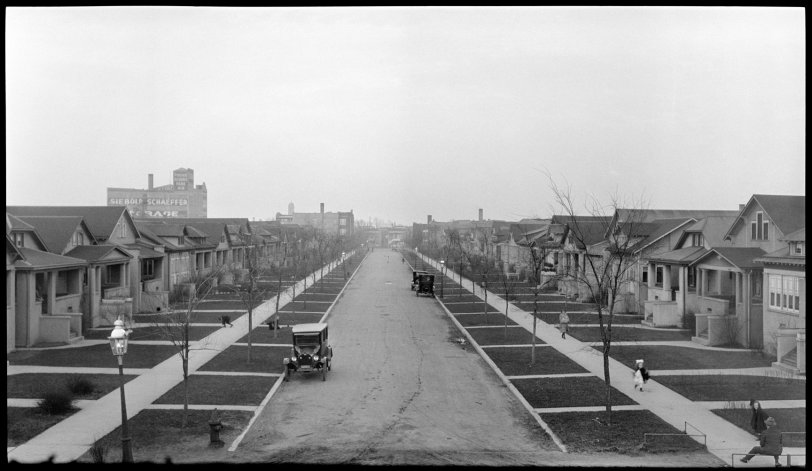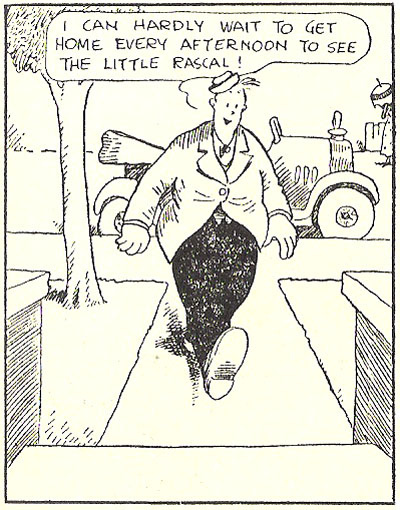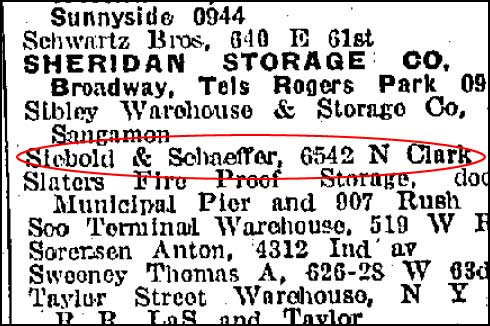


Framed or unframed, desk size to sofa size, printed by us in Arizona and Alabama since 2007. Explore now.
Shorpy is funded by you. Patreon contributors get an ad-free experience.
Learn more.

- Lofty addition
- In 1912
- Keenan Building
- Six years old
- Taken from the P.J. McArdle Roadway?
- It stood only 47 years
- Three track mind
- Incline to the right
- Reach for the sky, 1912 style
- No clean sweep
- Same Job Title, Same Face
- Sadly Lost
- Beautiful ...
- Where you get your kicks
- Aim High
- Pueblo Revival sisters
- Pueblo Neoclassicism
- Milk Man
- Regional dialect.
- Spielberg's inspiration
- Great Photo
- Loaf Story
- Do you still have the Rakes category?
- Could almost be a scene from the 1957 movie 'Hell Drivers'
- The Wages of Fear.
- Conspicuous by their absence
- Got Milk?
- All that aluminum
- No lefties
- Smoke 'em if you've got 'em
Print Emporium
Chicago: 1920s

Taken from the old elevated Union Pacific/North Line track looking due east up West Arthur Avenue toward North Clark in the Rogers Park neighborhood of northeast Chicago (Thanks TD for figuring that out). View full size.
Great picture, great comments.
I enjoyed taking long looks at this picture, and the great comments too. I grew up, in the seventies, on Sheridan and Glenlake. I was always jealous of kids who grew up in houses like these. I grew up in a highrise.
The Old Neighborhood
My grandparents purchased a building two blocks east of the position of this photo back in the late 1930s at the intersection of Wallen Ave and Clark. Our entire family resided in a bungalow home much like those in the pic in the adjacent neighborhood a mile to the west (West Rogers Park/ Westridge)from the early 50s through the late 70s. This community was an extremely prosperous area during that time period anchored by the Devon Ave business corridor.
I Grew Up Here
I grew up on this street, in the house at 1773 Arthur. It's rightmost house that's shown in full, the one with three vertical windows on the second floor.
My father's family moved into the house shortly after this photo was taken - my dad was 11 at the time - and my grandfather added dormers on the second floor, to make a separate apartment in the house.
Just south of this street were the barns for the city street cars. One of my earliest memories is of watching the streetcars rattle down Ravenwood Avenue and pull into the barns. After the streetcars were replaced with buses in the late 1950s, the city parked garbage trucks and snowplows on the site; now, it's a large police station.
The street is largely unchanged from when this photo was taken. The houses were built around the time of WWI, and all at the same time: if you walk up the street, you'll see the same three designs repeated in sequence. The houses also had the usual flourishes of homes built back then, including stained glass windows and oak floors. The houses were unusual for Chicago, though, in that they were built of firebrick covered with stucco, instead of being faced with brick or limestone.
The saplings in the picture were elms. Over the years, they grew into lovely shade trees, forming a cathedral arch over the street. However, the Dutch elm disease killed them all, and they were cut down in the late 1960s. The trees now on the street are maples and locusts that were planted in the 1970s.
The area just west of where the photo was taken was all truck farms in the 1920s. Later, it was developed and became a flourishing Jewish neighborhood. Nowadays, the Jewish people have moved on and their place has been taken by Indian and Pakistani immigrants. If you like Indian food, the intersection of Devon and Western, a short walk from where this photo was taken, is *the* place to go in Chicago - it also has the only halal KFC I've seen anywhere.
Many thanks to the poster, for bringing back so many memories.
It Looks Like 1921
I magnified the picture to 400% and looked at the car facing the camera. The logo on the radiator looks like the Chevy bowtie. From there I pulled out my Sixty Years of Chevrolet book and narrowed the car down to 1920 - 1922 based on fenders, radiator, body style, lights and other characteristics.
Illinois used a dash or dot separator between the digits (like 22-222 or 111-111) on a five or six digit plate between 1922 and 1937. Since this plate does not have a separator the license plate must be from before 1922.
Illinois license plates had black lettering on an orange background in 1920 and white lettering on a black background in 1921. This plate has white lettering.
Therefore, this appears to be a photograph from 1921.
William Wallen addition to Rogers Park
I live in Rogers Park, and have always loved this section of Arthur Avenue, as it's the closest thing Chicago has to a "bungalow court". The land these houses were built on (as well as that on which my own house was built) is called the William Wallen addition. The Chicago & Northwestern Railway purchased this land, which runs parallel to the tracks (now Metra), to build housing for railway employees. The first owner of my house was a CNW rail conductor! Wallen was an early settler of what later became Rogers Park, and he's honored by the naming of Wallen Avenue.
My Old Hood
Lived near here while going to graduate school at NU. I loved Rogers Park. Less expensive than most neighborhoods, but still pretty nice overall. Most diverse hood in the city for many years, may still be.
The trees
Undoubtedly the best part for me is seeing how young the trees were. You were alble to see the entire block without much difficulty. Now, the old trees block much of the view.
Gasoline Alley
Although he lived in an apartment on the Southside and then later in the country, this is the type of Chicago neighborhood that inspired Frank O. King when he created the long-running (1918 to date) "Gasoline Alley" comic strip. The homes he depicted were built before the automobile was prevalent and so did not have garages. If you owned your own home you could have added a garage with an alley entrance at the back of the property just as Noelani suggested. If you rented rather than owned, you could rent a garage from entrepreneurs who built them in the alleys behind their commercial property. These rows of garages were called Gasoline Alleys. Sometimes these rented garages were blocks away from where the car owner lived. Often, if you took public transportation to work, you would visit your car in its rented garage only on the weekends. Since there were many others renting in your alley that were not from your neighborhood, the garage communities were like a second home neighborhood for the weekend and days off, creating another whole set of friends.
The still running Gasoline Alley strip had the distinction of being the first comic in which the characters aged in real time, with babies being born and growing up and old folks dying. The panel below, which shows the main character Walt coming home to a house much like those in the picture above, is from the May 25, 1921 comic strip.

So few cars
Is it a weekday and most of the cars are someone else, or did most people not yet have cars? Or, maybe there are alleys in the back of the houses where more of the cars are parked.
Nowadays
Not only have the trees gotten bigger, the Model Ts have morphed into Hondas and SUVs!
Frozen in time
Seeing that little girl running enthusiastically toward the man sitting casually on the fence rail in the lower right of the photo highlights for me that it is truly like a frozen moment in time. Is that her mother walking fifty paces behind her with groceries?
Union Pacific (ex- Chicago & North Western)
For true-blue Chicagoans, the three Union Pacific commuter rail lines will always belong to the Chicago & North Western Railway, which was "absorbed" by the UPRR on October 1, 1995. Just as the elevated lines of the Chicago Transit Authority will always be known by their old route names, and not by their newer "color" names (Red Line, Blue Line, etc.) ...
Siebold and Schaeffer Storage
The 1923 City Directory gives the location, 6542 N Clark St. The building is now the home of Burrows Moving and Storage.

LOVE THIS SITE
Feels like the best kind of time travel.
Welcome
... to suburbia?
At least they put in decent sidewalks. In spite of the 1927 15 millionth Model T, carmania was still in check, or so it seems.
Rogers Park
The steeple in the distance of the upper left (visible if the photo is enlarged) is that of St. Ignatius Catholic Church.
After 91 Years
Same house, one way, new street lights and (probably) newer trees. Nice to see that, for the most part, the character of this quiet street has remained the same.
A bit older
Looking at the cars and the ad for Schaeffer beer, I would say this is the 1910's. Just my 2 cents.
[Schaeffer is a storage warehouse, not a beer. Also consider the format. This was imaged from a film negative, not a glass plate. - Dave]
Still there, bigger trees
About the Author
This is our first post from Pete Mauney, proprietor of Global Pillage. More about his collection here.
























On Shorpy:
Today’s Top 5